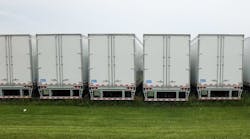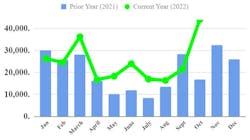U.S. trailer orders for October surged to 44,000, according to one trucking industry data firm, and above 47,000, according to another, as they rose far above September levels and the numbers of a year ago.
October net trailer orders of 47,860 units were 83% higher compared to last month, up 57% on a seasonally adjusted basis, and were 171% above those in October 2021, ACT Research officials cited from its State of the Industry: U.S. Trailers report, which provides a monthly rundown of current U.S. trailer market statistics, OEM build plans, and market indicators divided by all major trailer types, including backlogs, build, inventory, new orders, cancellations, net orders, and factory shipments.
See also: Trailer orders on the rise as OEMs prepare for a ‘rapid’ 2023
Another data aggregator, FTR Transportation Intelligence, pegged October trailer orders at 44,000, a 91% increase from the previous month and 161% higher than the previous October. FTR also said backlog levels jumped 13% on the increased orders after a downward trend for most of the year. October build rates were down 9% from September but were up 3% from October 2021.
Jennifer McNealy, ACT’s director of commercial vehicle market research and publications, said, “Discussions across the past month indicate trailer OEM business conditions, including 2023 demand, material/component supply chain, and labor, are on par with September, although swinging toward the ‘better’ side of the pendulum.”
“Demand overall remains healthy, cancellations are low, although we expect some cancel-rebooking activity to occur in Q4, and October’s backlog-to-build ratio saw an uptick in tandem with the increase in orders,” she added.
Regarding October orders, McNealy offered, “October orders were mixed, with some trailer categories up triple digits from September, others down double digits, and a few virtually unchanged. That said, seasonal adjustment does diminish some of the sensational increases.
“This year’s backlogs are filled and build slot availability in 2023 varies widely by OEM but continues to open more fully, which helps explain customers’ ability to place orders at the pace exhibited the past two months.”






